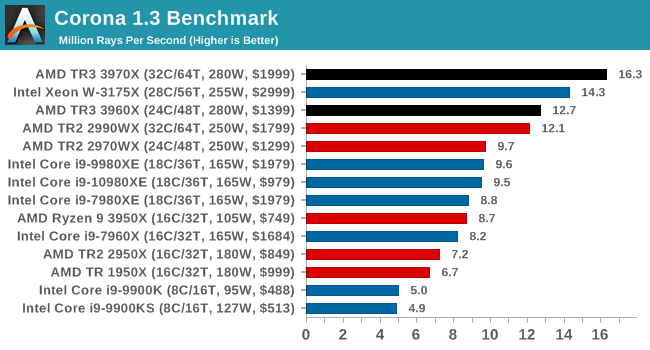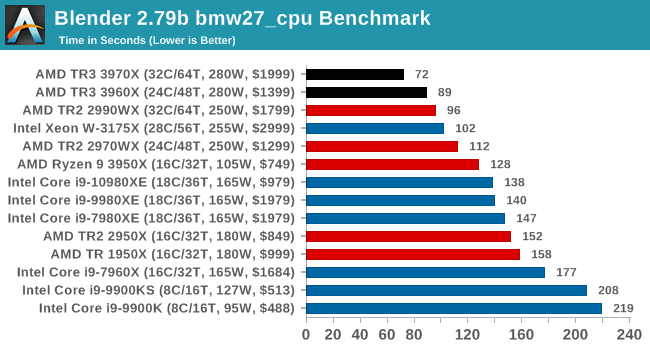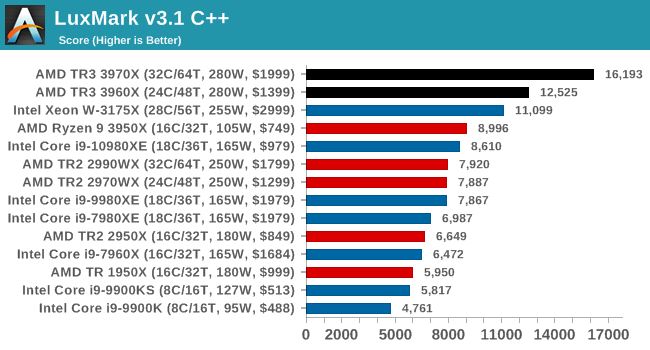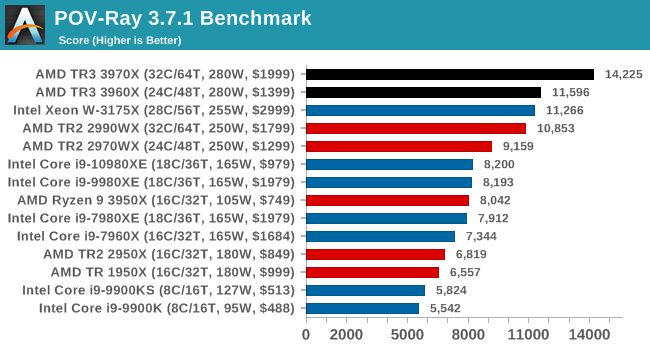The AMD Ryzen Threadripper 3960X and 3970X Review: 24 and 32 Cores on 7nm
by Dr. Ian Cutress, Andrei Frumusanu & Gavin Bonshor on November 25, 2019 9:05 AM ESTCPU Performance: Rendering Tests
Rendering is often a key target for processor workloads, lending itself to a professional environment. It comes in different formats as well, from 3D rendering through rasterization, such as games, or by ray tracing, and invokes the ability of the software to manage meshes, textures, collisions, aliasing, physics (in animations), and discarding unnecessary work. Most renderers offer CPU code paths, while a few use GPUs and select environments use FPGAs or dedicated ASICs. For big studios however, CPUs are still the hardware of choice.
All of our benchmark results can also be found in our benchmark engine, Bench.
Corona 1.3: Performance Render
An advanced performance based renderer for software such as 3ds Max and Cinema 4D, the Corona benchmark renders a generated scene as a standard under its 1.3 software version. Normally the GUI implementation of the benchmark shows the scene being built, and allows the user to upload the result as a ‘time to complete’.
We got in contact with the developer who gave us a command line version of the benchmark that does a direct output of results. Rather than reporting time, we report the average number of rays per second across six runs, as the performance scaling of a result per unit time is typically visually easier to understand.
The Corona benchmark website can be found at https://corona-renderer.com/benchmark

Being fully multithreaded, we see the order here follow core counts. That is except for the 32-core 2990WX sitting behind the 24-core 3960X, which goes to show how much extra performance is in the new TR generation.
Blender 2.79b: 3D Creation Suite
A high profile rendering tool, Blender is open-source allowing for massive amounts of configurability, and is used by a number of high-profile animation studios worldwide. The organization recently released a Blender benchmark package, a couple of weeks after we had narrowed our Blender test for our new suite, however their test can take over an hour. For our results, we run one of the sub-tests in that suite through the command line - a standard ‘bmw27’ scene in CPU only mode, and measure the time to complete the render.
Blender can be downloaded at https://www.blender.org/download/

We have new Threadripper records, with the 3970X almost getting to a minute to compute. Intel's nearest takes almost as long, but does only cost half as much. Again, the 3960X puts the 2990WX in its place.
LuxMark v3.1: LuxRender via Different Code Paths
As stated at the top, there are many different ways to process rendering data: CPU, GPU, Accelerator, and others. On top of that, there are many frameworks and APIs in which to program, depending on how the software will be used. LuxMark, a benchmark developed using the LuxRender engine, offers several different scenes and APIs.
In our test, we run the simple ‘Ball’ scene. This scene starts with a rough render and slowly improves the quality over two minutes, giving a final result in what is essentially an average ‘kilorays per second’.

Our LuxMark test again pushes both TR3 processors out in the lead.
POV-Ray 3.7.1: Ray Tracing
The Persistence of Vision ray tracing engine is another well-known benchmarking tool, which was in a state of relative hibernation until AMD released its Zen processors, to which suddenly both Intel and AMD were submitting code to the main branch of the open source project. For our test, we use the built-in benchmark for all-cores, called from the command line.
POV-Ray can be downloaded from http://www.povray.org/

More rendering, more wins for AMD. More losses for the 2990WX, even though on these tests it still beats the 10980XE quite easily.











245 Comments
View All Comments
MarkusB. - Tuesday, November 26, 2019 - link
I dont think and I dont hope that Intel is dead here. I do love the current status to be honest. Let them fight on the same level. I dont care if I use a AMD or an Intel chip at the end of the day. Let the CPUs get cheaper and more powerfull with a nice and working competition :) ... Intel will react on this and maybe in a few years Intel is back, just to be chased again by AMD. THAT´s how it should be ;)azfacea - Tuesday, November 26, 2019 - link
intel won in 2005 because GloFo (part of amd then) couldnt keep up. now its reverse with TSMC. intel is dead for goodZizo007 - Tuesday, November 26, 2019 - link
My last Intel was the 4770K which was a great CPU. Nowdays AMD is dominating CPU performance and I am very happy with my 4Ghz 1800X. I saw no reason to upgrade the 4770K until Ryzen has launched. Intel will catch up but this might take a year or two. Intel won't be out of business for sure and that would be bad for us since AMD will raise their prices if there is no competition. In the other hand Intel is entering the GPU market which will help them. AMD is currently suffering in the GPU market as they only have the 5700XT which cannot keep up with the RTX series and Big Navi needs a miracle to even match the old Turing architecture; Big Navy won't even be released this year.Dr. Denis - Tuesday, November 26, 2019 - link
It would be nice if AMD released an entry level TR3 with 16 cores at the $900-$1000 price point. It would be like a 3950x but with the extra memory bandwidth and pcie lanes, which are really important in a variety of workloads. I think the reason why this configuration doesn't exist yet is because AMD has "Ryzen" the HEDT bar to high making the market for it too small. What do you think?azfacea - Tuesday, November 26, 2019 - link
pointless product. if you are building a 3000 usd workstation you can afford 1400. if you just want pcie lanes, there are some older gen thread rippers out there for 200 usd. AMD should focus on rolling out 2 -- and not 1 -- 7nm APU dies. one quad core for 15w and below and a 8 core apu for 15 inch laptops and larger, 25W+Dr. Denis - Tuesday, November 26, 2019 - link
Well... The APU market is another story since its the only place where AMD is still behind Intel in efficiency, and consequently, in performance. We all expect zen2 will revert this in 2020.Back to the workstation side, it seems now that the best option for a ~16 core system for memory bound applications is the good old Skylake
CyrIng - Tuesday, November 26, 2019 - link
Thank you AnandTech for this review.Talking about HEDT processing, why don't include Linux benchmark results ? Do games scores make a difference for a super computer...
Samus - Wednesday, November 27, 2019 - link
I need this to decompress my torrents. I'm tired of waiting 10 seconds for a bluray to extract and would rather wait 4 seconds...it's movie time!335 GT - Wednesday, November 27, 2019 - link
AMD's biggest problem now is making enough of these. Every EPYC is sold before it leaves the fab and I suspect the same is happening with the desktop chips.ballsystemlord - Wednesday, November 27, 2019 - link
No spelling or grammar errors found! Nice work, guys!